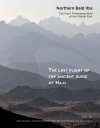![The Last Flight of the Ancient Guide of Hajj The Last Flight of the Ancient Guide of Hajj]()
Click to have a closer look
About this book
Customer reviews
Related titles
About this book
The printed version of this book is now out of print, though a PDF version can be downloaded from http://www.thelastflight.org/
A conservation struggle against time was fought in Syria between 2002 and 2011, the aim being to prevent the last known and genetically unique population of Northern Bald Ibis (Geronticus eremita) in the Middle East from becoming extinct.
The Nothern Bald Ibis had been declared extinct in Syria from the early 30s and in the whole Middle East in 1989. The news of the discovery of a relic colony of 7 individuals of this species in Palmyra desert, Syria, in 2002 made headlines on international media; reviving the hopes to be still on time to rescue the oriental population from extinction – and suddenly turning the species as the most threatened one in the Middle East.
The conservation saga in Syria began well in 2002 and achieved important results between 2002 and mid-2004. Due to a change of management, a gap in efforts was created starting from mid-2004 and the first significant setbacks ensued in the form of two breeding failures in 2005 and 2008. The project continued with alternating fortunes up to 2009-2010 while the colony size in parallel declined inexorably. At the onset of the unrest in Syria in 2011 the fate of the last Northern Bald Ibis colony of the Middle East was sealed with only one pair left. 2015 was the first year that no bird returned to the breeding grounds in Palmyra – the same year when the millenary enchanted ruins of Palmyra were destroyed by the war.
The recent – most likely final – extinction of this ancient and iconic population of Northern Bald Ibis is fully documented. The Last Flight of the Ancient Guide of Hajj was designed to provide an independent recount of this conservation saga and to set the record straight.
Customer Reviews (2)
-
Have we been given the full picture?
By
Richard
6 Sep 2017
Written for Paperback
Gianluca Serra’s book on the Northern Bald Ibis in the Middle East has super photos and summarises some published literature that may not be widely read, but be aware it gives an interesting but not necessarily holistic perspective – especially in as much as what it doesn't say. No mention of some aspects, including the support and work of RSPB and BirdLife International, for example. Also, I couldn’t find any mention of the African-Eurasian Migratory Waterbird Agreement (AEWA) Species Action Plan process for this species, so crucial in ensuring sound and coordinated conservation actions for migratory birds.
Richard Porter
0 of 2 found this helpful
-
Was this helpful to you? Yes No
-
Neutral perspective
By
Stefan
27 Jan 2018
Written for Paperback
The involvement of RSPB and Birdlife in the NBI Syria project is duly reported in the booklet by Serra. The inadequate support from these two organizations is thoroughly documented in a quantitative way in chapter 4. The author was very diplomatic in not explicitly stating that the inadequate support provided by these 2 organizations was one of the main drives for the final demise of the colony. This problem is never mentioned in the glossy online pages of RSPB and Birdlife – where everything is reported as a success. Serra’s independent perspective is needed to document what has happened on the ground during those years.
On the other hand, I believe that the AEWA action plan is not mentioned because it had null implications for this project – like it so often happens. A list of objectives and actions without any follow up in the reality.
3 of 3 found this helpful
-
Was this helpful to you? Yes No




























